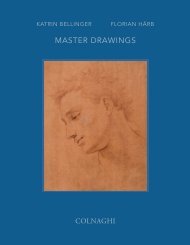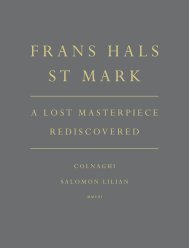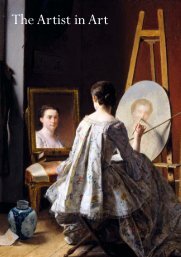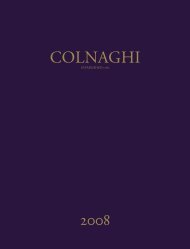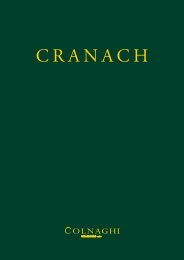2007 Catalogue - Colnaghi
2007 Catalogue - Colnaghi
2007 Catalogue - Colnaghi
You also want an ePaper? Increase the reach of your titles
YUMPU automatically turns print PDFs into web optimized ePapers that Google loves.
Provenance: Sir Francis Cook, 1st Bt., Viscount<br />
de Monserrate (1817-1901), Doughty House,<br />
Richmond, Surrey (hung in the Long Gallery); by<br />
descent to Sir Francis Cook, 4th Bt. (1907-1978), the<br />
late husband of Lady Brenda Cook.<br />
Exhibited: Included in a touring exhibition of English<br />
museums organised by the Art Exhibitions Bureau as<br />
part of the Cook Collection Group, Old Master<br />
portraits from the Cook collection: Brighton Art Gallery;<br />
Dudley Art Gallery; Mansfield Museum and Art<br />
Gallery; Doncaster Art Gallery and Museum;<br />
Northampton Art Gallery; Southampton Art Gallery;<br />
the Graves Art Gallery, Sheffield; Darlington Public<br />
Library, January 1947 - January 1948; To be included<br />
in the forthcoming exhibition Masterpieces of<br />
Seventeenth-Century Dutch Portrait Painting, National<br />
Gallery, London, 27th June – 16th October <strong>2007</strong> and<br />
Royal Picture Gallery Mauristshuis, Den Haag, 13th<br />
October <strong>2007</strong> – 13th January 2008.<br />
Literature: M. Brockwell, H. Cook and F. Cook,<br />
An Abridged <strong>Catalogue</strong> of the Pictures at Doughty House,<br />
Richmond, belonging to Sir Frederick Cook Bart.,<br />
Visconde de Monserrate, 1914, p. 22, no. 102, in the<br />
Long Gallery; J.O. Kronig, A <strong>Catalogue</strong> of the Paintings<br />
at Doughty House, Richmond, and Elsewhere in the<br />
Collection of Sir Frederick Cook Bt., vol. II, Dutch and<br />
Flemish Schools, London 1914, p. 53, no. 278,<br />
illustrated; C. Hofstede de Groot, A <strong>Catalogue</strong><br />
Raisonné of the Works of the Most Eminent Dutch<br />
Painters of the Seventeenth Century, London 1916<br />
(English edn.), vol. VI, p. 597, no. 556 (size wrongly<br />
given as 211 /<br />
2 x 27 in.); M.W. Brockwell, ‘The Cook<br />
Collection Part II – The Flemish and Dutch Schools’,<br />
Connoisseur, vol. XLVIII, May 1917, p. 28; [M.W.<br />
Brockwell], Abridged <strong>Catalogue</strong> of the Pictures at<br />
Doughty House, Richmond, Surrey, in the Collection of<br />
Sir Herbert Cook Bt., London 1932, p.41, no. 278;<br />
F.W. Robinson, Dutch Life in the Golden Century,<br />
New York 1975, p. 47, no. 32; W. Sumowski, Gemälde<br />
der Rembrandt-Schüler, vol. III, London 1983, p. 2037,<br />
no. 1444.<br />
05<br />
Nicolaes Maes<br />
(Dordrecht 1623 – 1693 Amsterdam)<br />
Group Portrait of a Family in an Italianate Garden with a Fountain<br />
Oil on canvas<br />
60 7 /8 x 67 in. (153.1 x 170.2 cm.)<br />
26<br />
This family portrait provides us with an impressive<br />
example of Nicolaes Maes’s artistic skill. He was for a<br />
time the most sought-after portraitist in Holland and<br />
is regarded today as one of the most gifted of<br />
Rembrandt’s pupils. From the nineteenth century until<br />
recently the <strong>Colnaghi</strong> picture formed part of the Cook<br />
Collection originally displayed in Doughty House,<br />
Richmond, from which have come such famous works<br />
as van Eyck’s Three Maries at the Open Sepulchre in the<br />
Boijmans van Beuningen Museum, Rotterdam. A<br />
black-and-white illustration in Werner Sumowski’s<br />
Gemälde der Rembrandt-Schüler gave only an<br />
inadequate impression of the colourful composition,<br />
especially as the wrong dimensions were constantly<br />
handed down in error in the catalogues. 1 The<br />
imposing painting is in fact one of the largest known<br />
canvases by Maes.<br />
The six family members are depicted against the<br />
backdrop of a picturesque park containing the<br />
fragment of an antique relief, a dolphin fountain, vases<br />
and trees with dense foliage. The costumes of the two<br />
sons are suggestive of mythological figures such as<br />
Meleager. At the beginning of the 1660s Maes had<br />
already created a series of historicizing portraits of<br />
young ‘huntsmen’, still at that time closely imitating<br />
pictures by Jacob Gerritsz Cuyp and Jan Mijtens. 2 By<br />
comparison with these early, schematic examples which<br />
had a stiff effect, the pose of both boys, especially that<br />
of the elder, is more relaxed, almost bordering on a<br />
dance. The pose of the latter is only echoed in Maes’<br />
work on one other occasion, namely in the Portrait of<br />
a Young Man in the Alte Pinakothek, Munich. 3 The<br />
source is to be found neither in portraits by his<br />
contemporaries nor in the sculpture of antiquity but<br />
in the graphic works of Hubert Goltzius. 4 The<br />
agreement of the pose with the (mirror-inverted)<br />
engraving The Standard Swinger, 1587 is too striking<br />
to have occurred by chance. 5



